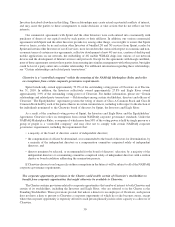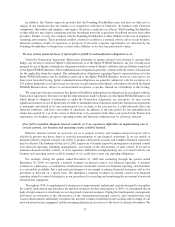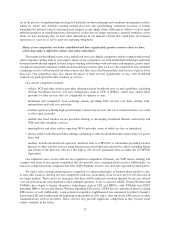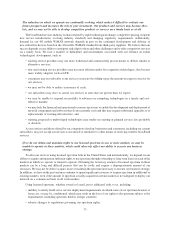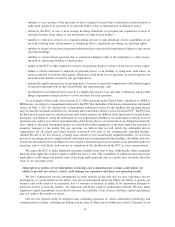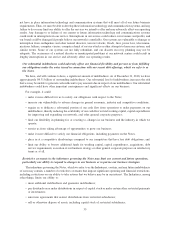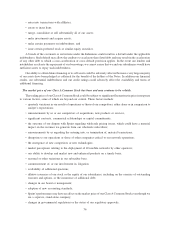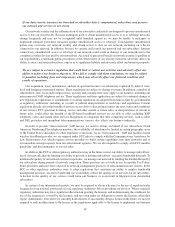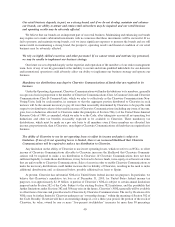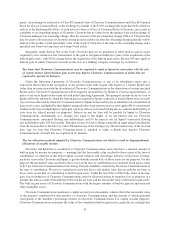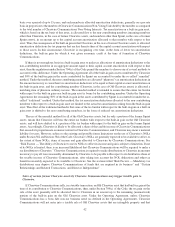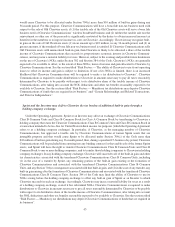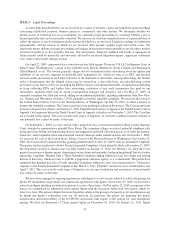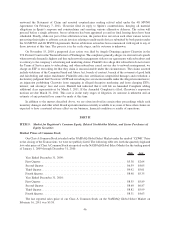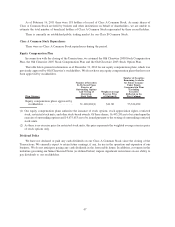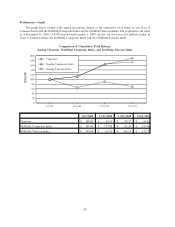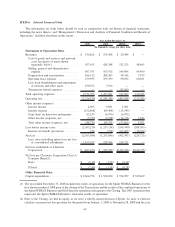Clearwire 2010 Annual Report Download - page 45
Download and view the complete annual report
Please find page 45 of the 2010 Clearwire annual report below. You can navigate through the pages in the report by either clicking on the pages listed below, or by using the keyword search tool below to find specific information within the annual report.Our retail business depends, in part, on a strong brand, and if we do not develop, maintain and enhance
our brands, our ability to attract and retain retail subscribers may be impaired and our retail business
and operating results may be adversely affected.
We believe that our brands are an important part of our retail business. Maintaining and enhancing our brands
may require us to make substantial investments with no assurance that these investments will be successful. If we
fail to promote and maintain strong brands, or if we incur significant expenses to promote the brands and are still
unsuccessful in maintaining a strong brand, the prospects, operating results and financial condition of our retail
business may be adversely affected.
We rely on highly skilled executives and other personnel. If we cannot retain and motivate key personnel,
we may be unable to implement our business strategy.
Our future success depends largely on the expertise and reputation of the members of our senior management
team. Loss of any of our key personnel or the inability to recruit and retain qualified individuals for our domestic
and international operations could adversely affect our ability to implement our business strategy and operate our
business.
Mandatory tax distributions may deprive Clearwire Communications of funds that are required in its
business.
Under the Operating Agreement, Clearwire Communications will make distributions to its members, generally
on a pro rata basis in proportion to the number of Clearwire Communications Class A Common Units and Clearwire
Communications Class B Common Units, which we refer to collectively as the Clearwire Communications Non-
Voting Units, held by each member, in amounts so that the aggregate portion distributed to Clearwire in each
instance will be the amount necessary to pay all taxes then reasonably determined by Clearwire to be payable with
respect to its distributive share of the taxable income of Clearwire Communications (including any items of income,
gain, loss or deduction allocated to Clearwire under the principles of Section 704(c) of the United States Internal
Revenue Code of 1986, as amended, which we refer to as the Code, after taking into account all net operating loss
deductions and other tax benefits reasonably expected to be available to Clearwire. These mandatory tax
distributions, which must be made on a pro rata basis to all members even if those members are allocated less
income, proportionately, than is Clearwire, may deprive Clearwire Communications of funds that are required in its
business.
The ability of Clearwire to use its net operating losses to offset its income and gain is subject to
limitation. If use of its net operating losses is limited, there is an increased likelihood that Clearwire
Communications will be required to make a tax distribution to Clearwire.
Any limitation on the ability of Clearwire to use its net operating losses, which we refer to as NOLs, to offset
income of Clearwire Communications allocable to Clearwire increases the likelihood that Clearwire Communi-
cations will be required to make a tax distribution to Clearwire. If Clearwire Communications does not have
sufficient liquidity to make those distributions, it may be forced to borrow funds, issue equity or sell assets on terms
that are unfavorable to Clearwire Communications. Sales of assets in order to enable Clearwire Communications to
make the necessary distributions could further increase the tax liability of Clearwire, resulting in the need to make
additional distributions and, as discussed below, possible additional tax loans to Sprint.
At present, Clearwire has substantial NOLs for United States federal income tax purposes. In particular, we
believe that Clearwire’s cumulative tax loss as of December 31, 2010, for United States federal income tax
purposes, was approximately $2.19 billion. A portion of Clearwire’s NOLs is subject to certain annual limitations
imposed under Section 382 of the Code. Subject to the existing Section 382 limitations, and the possibility that
further limitations under Sections 382 and 384 may arise in the future, Clearwire’s NOLs generally will be available
to offset items of income and gain allocated to Clearwire by Clearwire Communications. The use by Clearwire of its
NOLs may be further limited if Clearwire undergoes an “ownership change,” within the meaning of Section 382 of
the Code. Broadly, Clearwire will have an ownership change if, over a three-year period, the portion of the stock of
Clearwire, by value, owned by one or more “five-percent stockholders” increases by more than 50 percentage
40


